A Multi-Analytical Study of an Ancient Egyptian Limestone Stele for Knowledge and Conservation Purposes: Recovering Hieroglyphs and Figurative Details by Image Analysis
Abstract
:1. Introduction
2. Materials and Methods
2.1. Materials
2.2. Experimental Study and Methods
3. Results
3.1. Characterization, Provenance, and Stratigraphical Age of the Limestone Support
3.2. Technique of Execution and State of Preservation of the Support
3.3. The Decoration: Recovering the Figures and Their Accompanying Hieroglyphic Inscriptions
- The weser (head and neck of canine animal) and kheper (scarab) sign in the prenomen of the king, Weser-khepru-Re (correctly reconstructed by Tosi and Roccati, but not actually seen).
- The independent pronoun inek (“I (am)”: a jar above a shallow basket with a handle, read as k) beginning the goddess Mut’s utterance.
- The cobra sign (dj) at the beginning of the text above Amun.
- The .k pronoun (the shallow basket with a handle) in the text above Amun.
4. Discussion
Author Contributions
Funding
Acknowledgments
Conflicts of Interest
References
- Bruyère, B. Mert Seger à Deir el Médineh. In Mémoire Publiées par les Membres de L’institut Français D’archéologie Orientale du Caire, 1st ed.; IFAO: Le Caire, Egypt, 1929–1930; Volume 1–2. [Google Scholar]
- Tosi, M.; Roccati, A. Stele e altre epigrafi di Deir el Medina. N. 50001-50262. In Catalogo del Museo Egizio di Torino; Serie Seconda, Collezioni 1; Edizioni d’Arte Fratelli Pozzo: Torino, Italy, 1972. [Google Scholar]
- Del Vesco, P.; Poole, F. Deir el-Medina in the Egyptian Museum of Turin. An Overview, and the Way Forward. In Outside the Box: Selected Papers from the Conference “Deir el-Medina and the Theban Necropolis in Contact”, Liège, Belgium, 27–29 October 2014; Dorn, A., Polis, S., Eds.; Presses Universitaires de Liège: Liège, Belgium, 2018. [Google Scholar]
- Ghabriel, I. The So-Called Oratory of Ptah and Mertseger Re-Examined. In Proceedings of the Deir el-Medina through the Kaleidoscope—2018 Turin International Workshop, Modena and Torino, Italy, 8–10 October 2018. [Google Scholar]
- Sambuelli, L.; Böhm, G.; Capizzi, P.; Cardarelli, E.; Cosentino, P. Comparison between GPR measurements and ultrasonic tomography with different inversion algorithms: An application to the base of an ancient Egyptian sculpture. J. Geophys. Eng. 2011, 8, S106–S116. [Google Scholar] [CrossRef]
- Spoladore, A. The stele S.06145 from the village of Deir El-Medina and conserved in the Egyptian Museum of Turin: Handling, Reading and Conservation Problems. Master’s Thesis, University of Turin, Venaria Reale, Italy, 25 November 2019. [Google Scholar]
- Capizzi, P.; Cosentino, P.L.; Schiavone, S. Some tests of 3D ultrasonic traveltime tomography on the Eleonora d’Aragona statue (F. Laurana, 1468). J. Appl. Geophys. 2013, 91, 14–20. [Google Scholar] [CrossRef] [Green Version]
- Bown, P.R.; Young, J.R. Techniques. In Calcareous Nannofossil Biostratigraphy. British Micropalaeontological Society Series; Bown, P.R., Ed.; Chapman and Hall: London, UK, 1998; pp. 1–15. [Google Scholar]
- Oleari, C. Misurare il Colore; Hoepli: Florence, Italy, 2008; pp. 53–60. [Google Scholar]
- Salerno, E.; Tonazzini, A.; Grifoni, E.; Lorenzetti, G.; Legnaioli, S.; Lezzerini, M.; Marras, L.; Palleschi, V. Analysis of multispectral images in cultural heritage and archaeology. J. Appl. Laser Spectrosc. 2014, 1, 22–27. [Google Scholar]
- Agnini, C.; Monechi, S.; Raffi, I. Calcareous nannofossil biostratigraphy: Historical background and application in Cenozoic chronostratigraphy. Lethaia 2017, 50, 447–463. [Google Scholar] [CrossRef]
- Okada, H.; Bukry, D. Supplementary modification and introduction of code numbers to the low-latitude coccolith biostratigraphic zonation (Bukry, 1973; 1975). Mar. Micropaleontol. 1980, 5, 321–325. [Google Scholar] [CrossRef]
- Martini, E. Standard Tertiary and Quaternary calcareous nannoplankton zonation. In Proceedings of the II Planktonic Conference, Roma, 1970; Farinacci, A., Ed.; Edizioni Tecnoscienza: Rome, Italy, 1971; Volume 2, pp. 739–785. [Google Scholar]
- Abu-Ali, R.; El-Kammar, A.; Zakaria, A.; El-Shafeiy, M.; Kuss, J. Paleo-environmental reconstructions of the Upper Cretaceous-Paleogene successions, Safaga, Egypt. J. Afr. Earth Sci. 2019, 149, 170–193. [Google Scholar] [CrossRef]
- Aubry, M.P.; Berggren, W.A.; Dupuis, C.; Ghaly, H.; Ward, D.; King, C.; Knox, R.; Ouda, K.; Youssef, M.; Fathi Galal, W. Pharaonic necrostratigraphy: A review of geological and archaeological studies in the Theban Necropolis, Luxor, West Bank, Egypt. Terra Nova 2009, 21, 237–256. [Google Scholar] [CrossRef]
- Aubry, M.-P.; Ouda, K.; Dupuis, C.; Berggren, W.A.; Van Couvering, J.A.; The Members of the Working Group on the Paleocene/Eocene Boundary. The Global Standard Stratotype-section and Point (GSSP) for the Eocene Series in the Dababiya section (Egypt). Episodes 2007, 30, 271–286. [Google Scholar] [CrossRef] [PubMed] [Green Version]
- King, C.; Dupuis, C.; Aubry, M.P.; Berggren, W.A.; Knox, R.O.B.; Galal, W.-F.; Baele, J.-M. Anatomy of a mountain: The Thebes limestone formation (lower Eocene) at Gebel Gurnah, Luxor, Nile valley, upper Egypt. J. Afr. Earth Sci. 2017, 136, 61–108. [Google Scholar] [CrossRef]
- Newman, R.; Serpico, M. Adhesive and Binders. In Ancient Egyptian Materials and Technology; Nicholson, P.T., Shaw, I., Eds.; Cambridge University Press: Cambridge, UK, 2000; pp. 475–493. [Google Scholar]
- Legnaioli, S.; Grifoni, E.; Lorenzetti, G.; Marras, L.; Pardini, L.; Palleschi, V.; Salerno, E.; Tonazzini, A. Enhancement of hidden patterns in paintings using statistical analysis. J. Cult. Herit. 2013, 14, S66–S70. [Google Scholar] [CrossRef]
- Legnaioli, S.; Lorenzetti, G.; Cavalcanti, G.H.; Grifoni, E.; Marras, L.; Tonazzini, A.; Salerno, E.; Pallecchi, P.; Giachi, G.; Palleschi, V. Recovery of archaeological wall paintings using novel multispectral imaging approaches. Herit. Sci. 2013, 1, 1–9. [Google Scholar] [CrossRef] [Green Version]
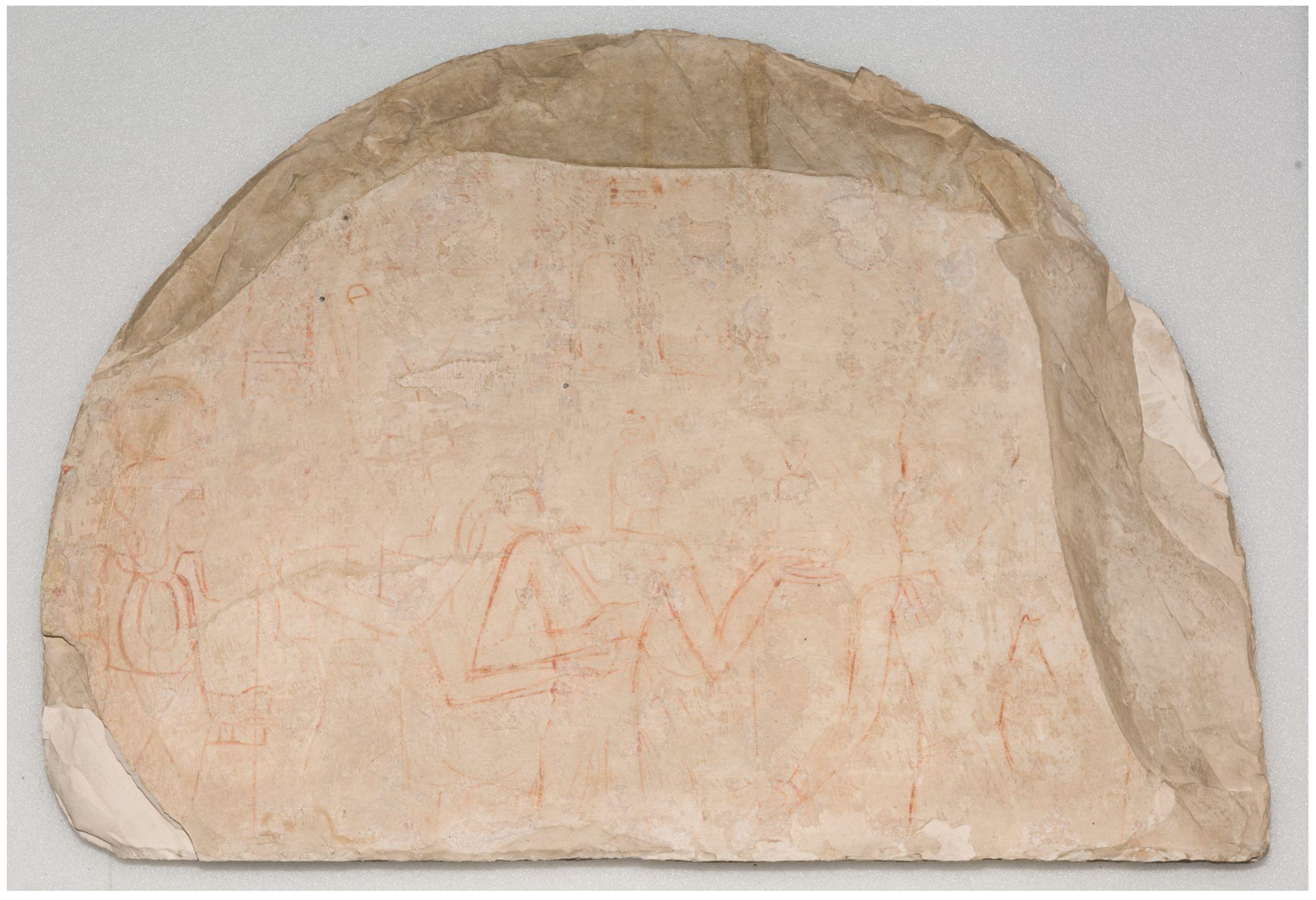
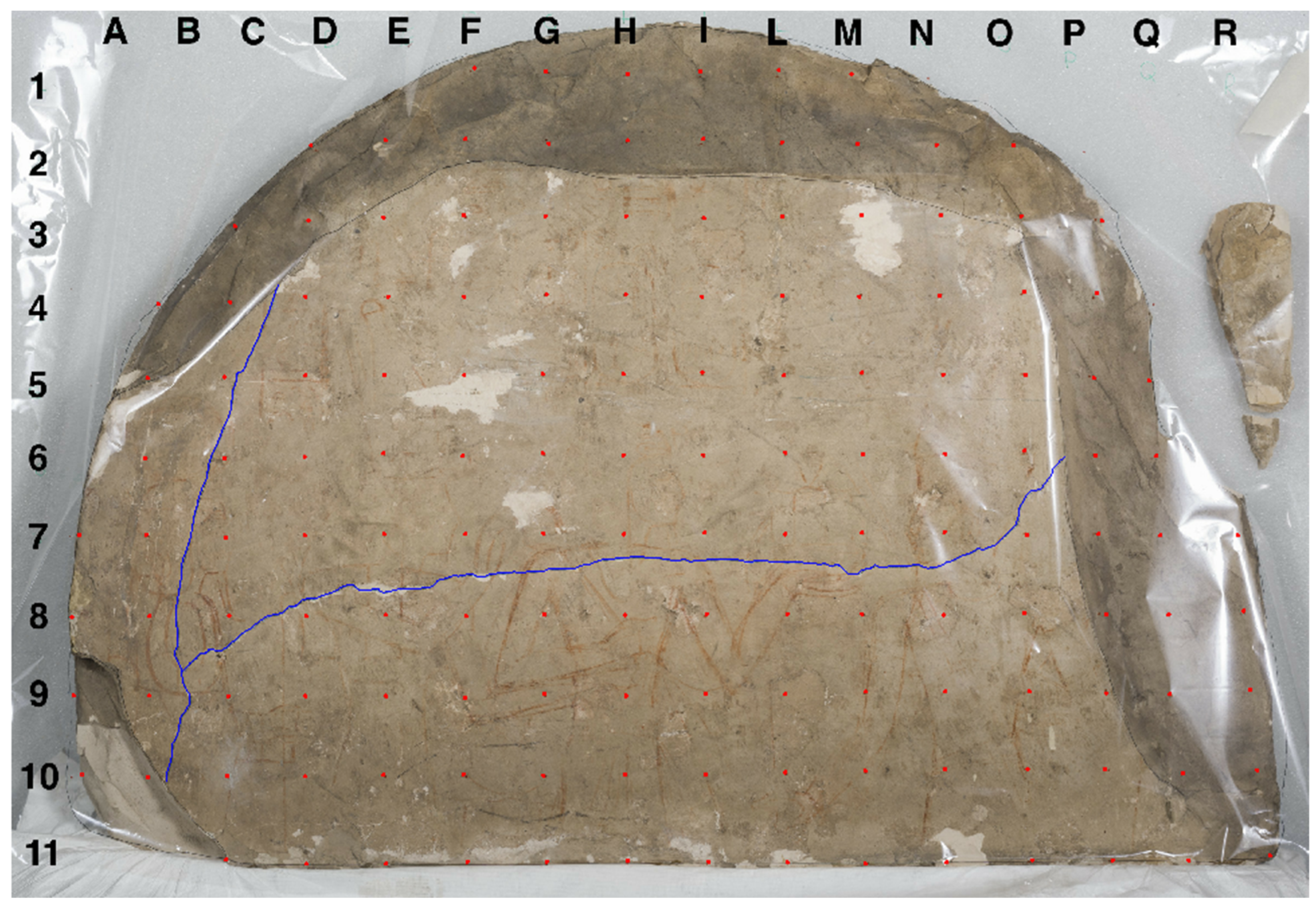
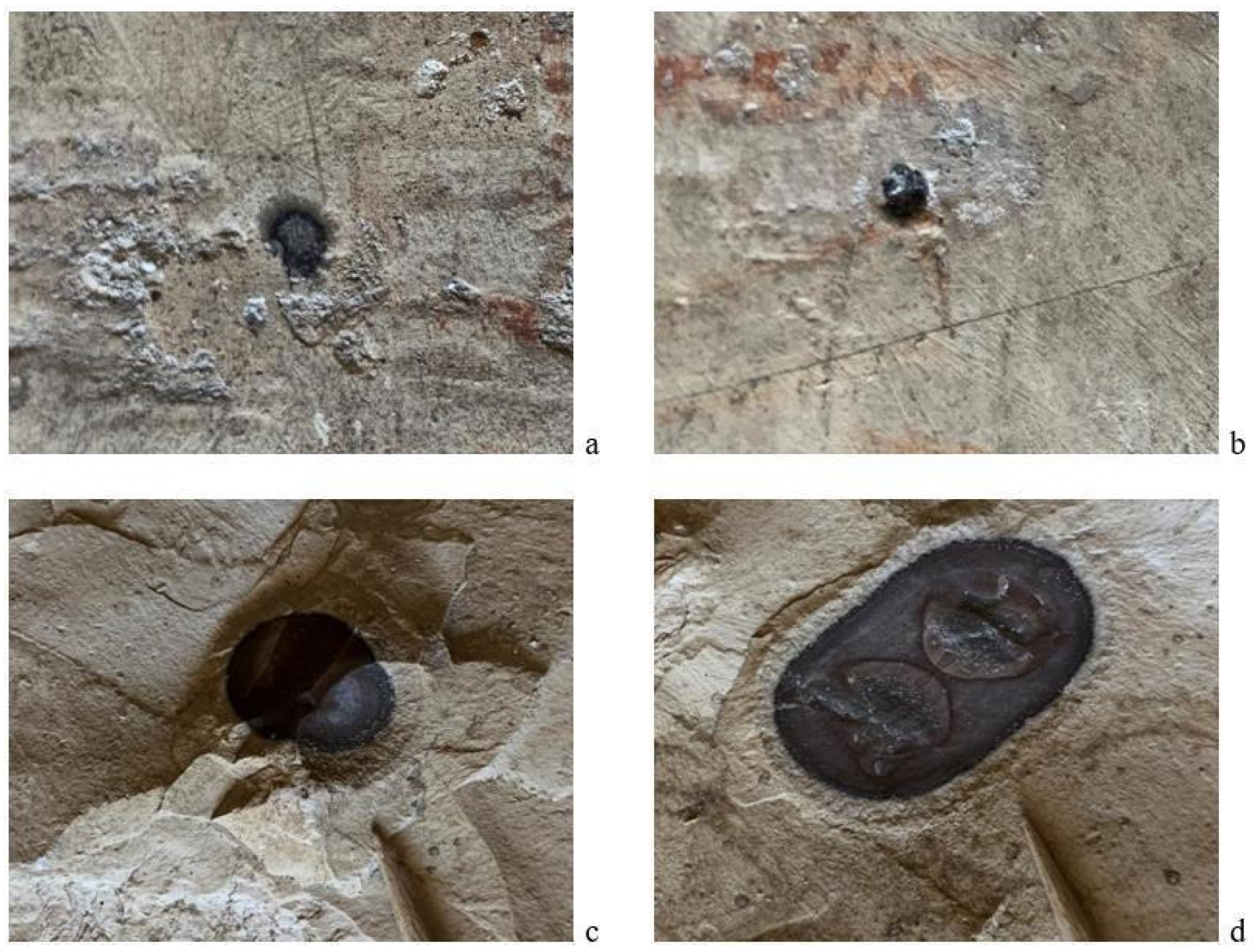
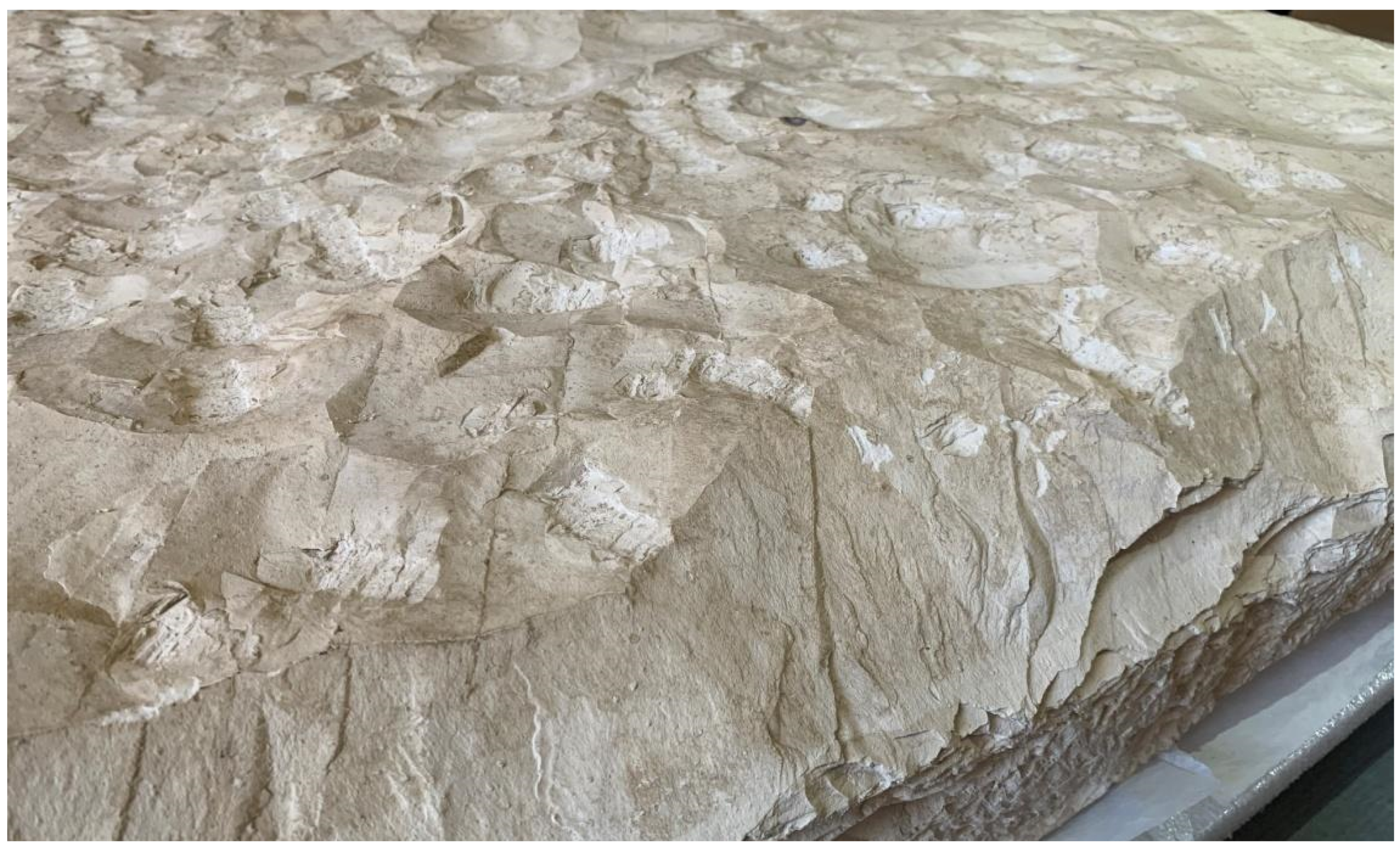
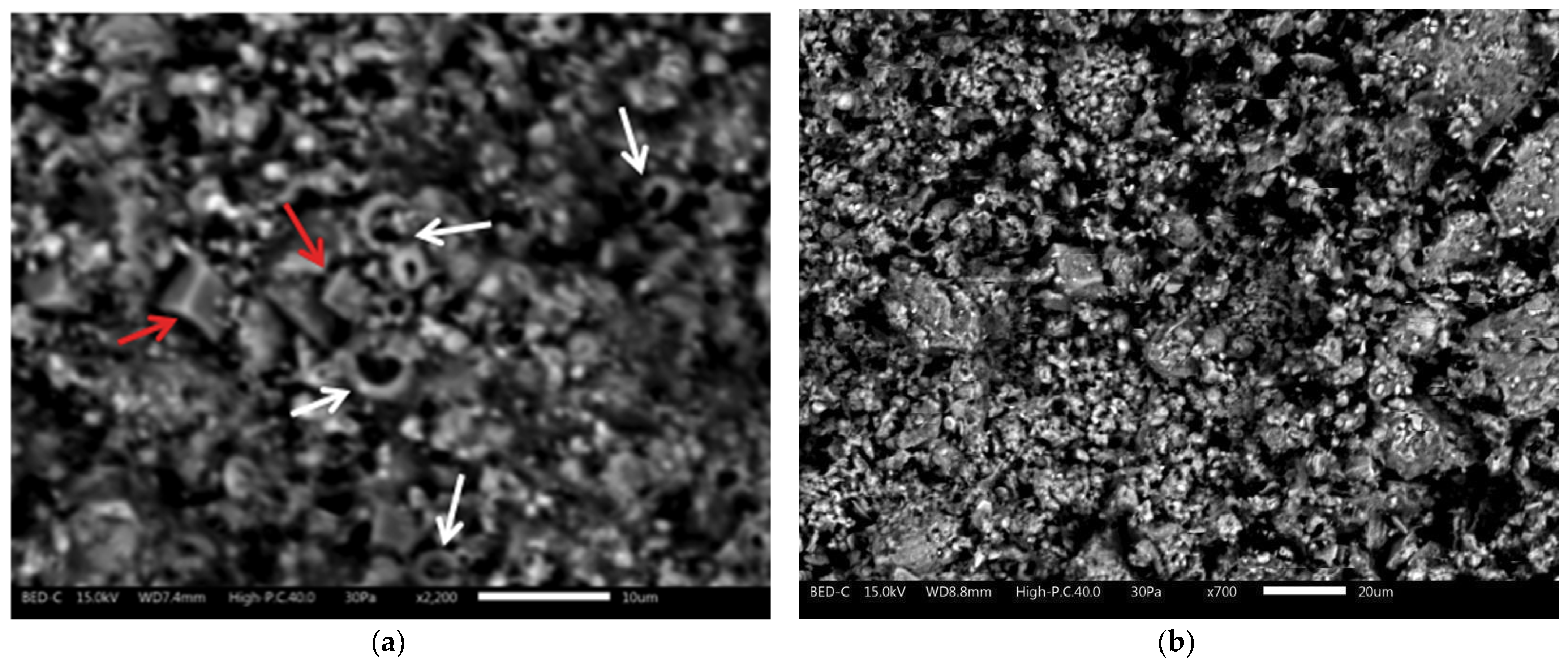


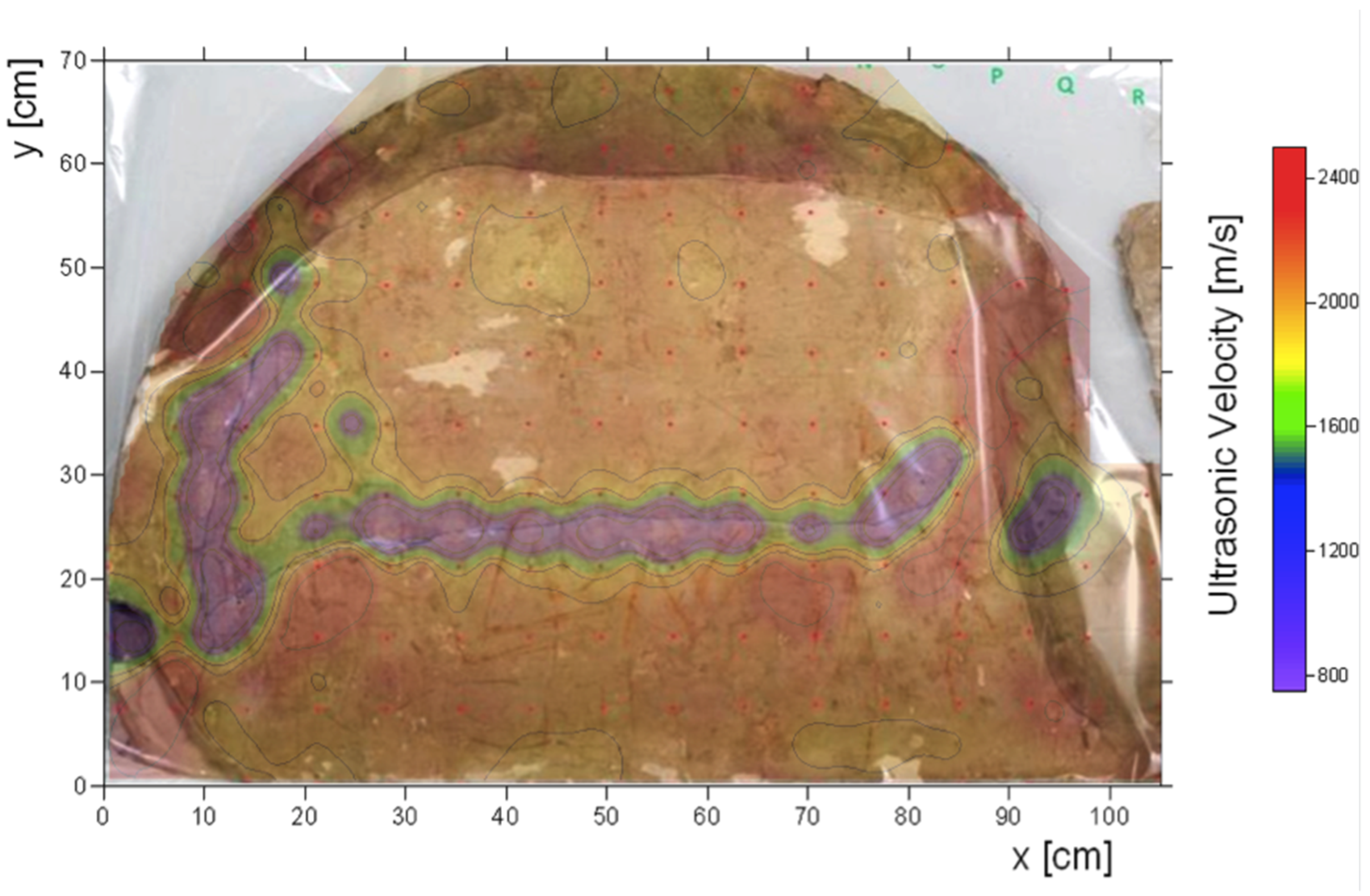
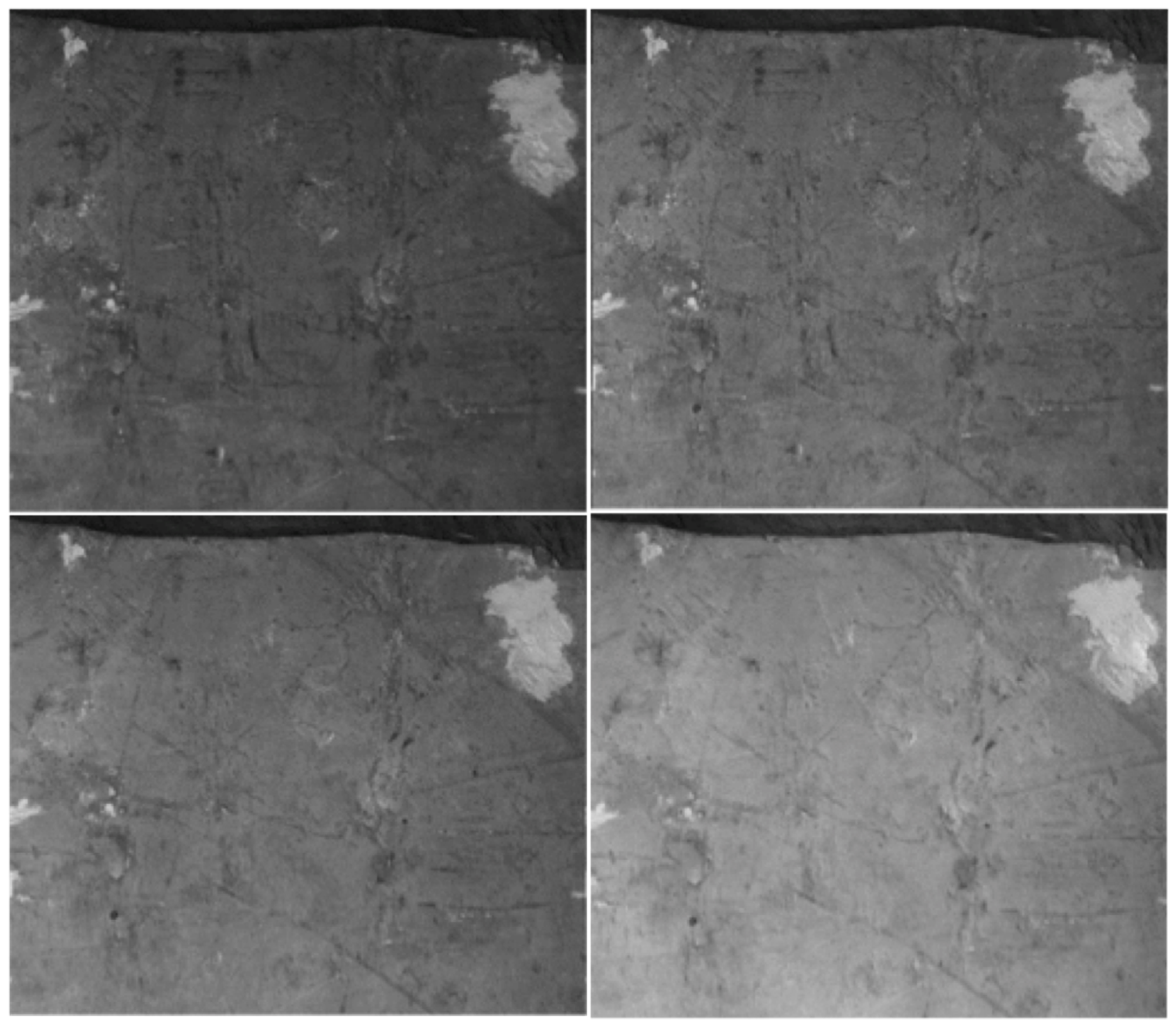

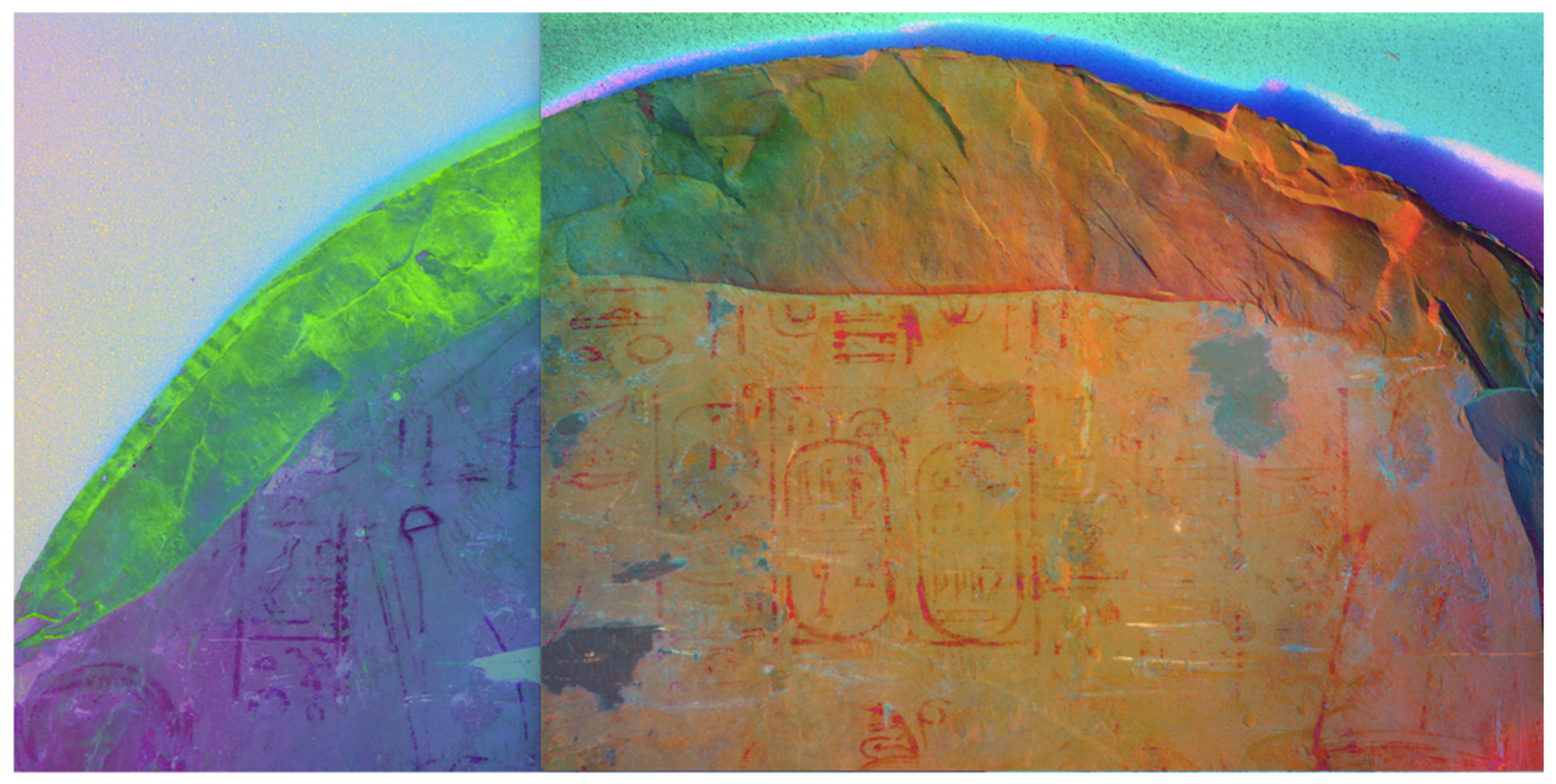
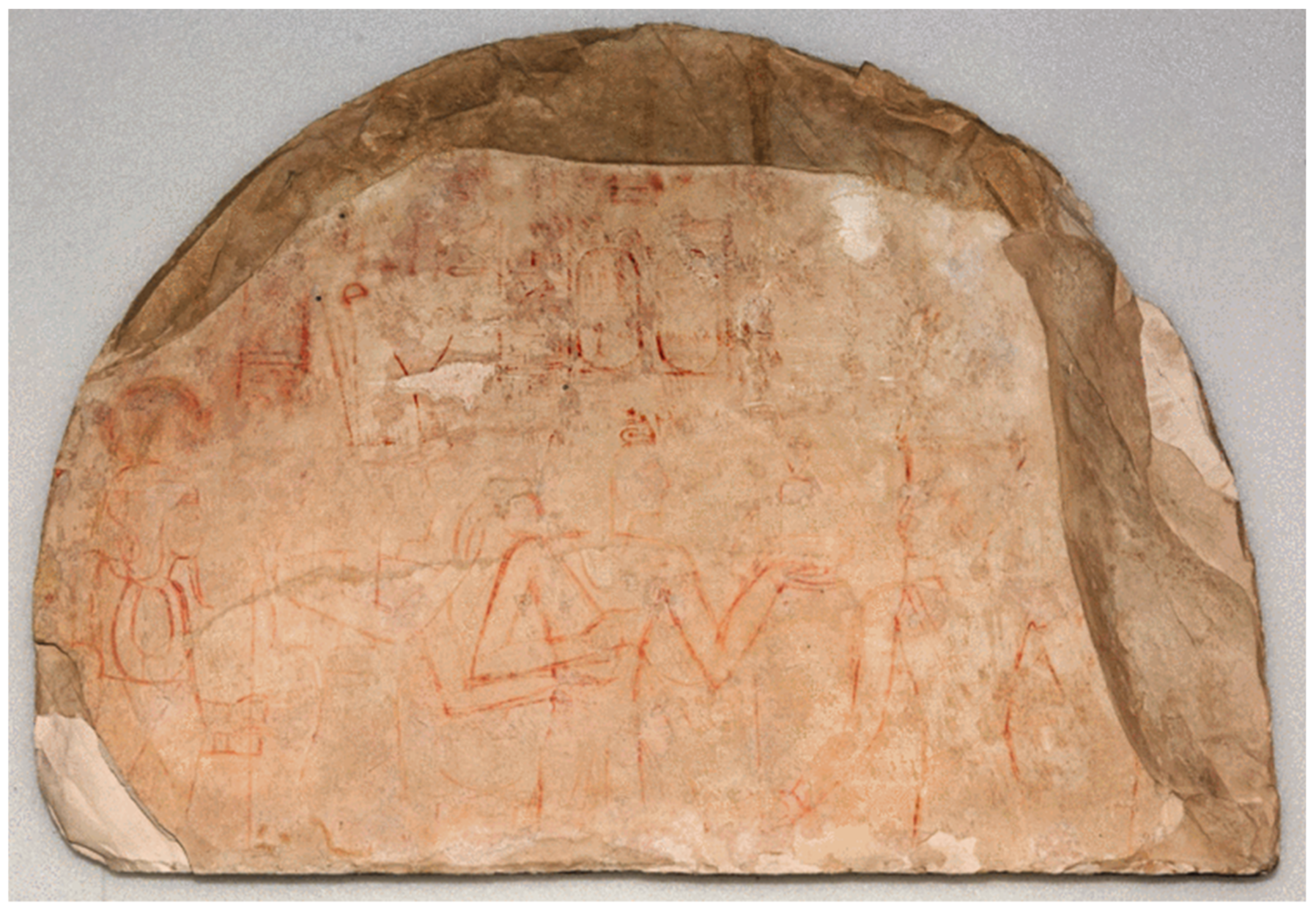
| Spectral Band (nm) | Vis Acquisition Time (s) | UV Acquisition Time (s) | Aperture |
|---|---|---|---|
| 400 | 10 | 15 | 11 |
| 450 | 10 | 15 | 11 |
| 500 | 10 | 30 | 11 |
| 550 | 1 | 30 | 11 |
| 600 | 1 | 45 | 11 |
| 650 | 1 | 90 | 11 |
| 850 | 1 | 90 | 11 |
| 950 | 1 | 120 | 11 |
| 1050 | 15 | 400 | 11 |
Publisher’s Note: MDPI stays neutral with regard to jurisdictional claims in published maps and institutional affiliations. |
© 2021 by the authors. Licensee MDPI, Basel, Switzerland. This article is an open access article distributed under the terms and conditions of the Creative Commons Attribution (CC BY) license (https://creativecommons.org/licenses/by/4.0/).
Share and Cite
Cavaleri, T.; Legnaioli, S.; Lozar, F.; Comina, C.; Poole, F.; Pelosi, C.; Spoladore, A.; Castelli, D.; Palleschi, V. A Multi-Analytical Study of an Ancient Egyptian Limestone Stele for Knowledge and Conservation Purposes: Recovering Hieroglyphs and Figurative Details by Image Analysis. Heritage 2021, 4, 1193-1207. https://doi.org/10.3390/heritage4030066
Cavaleri T, Legnaioli S, Lozar F, Comina C, Poole F, Pelosi C, Spoladore A, Castelli D, Palleschi V. A Multi-Analytical Study of an Ancient Egyptian Limestone Stele for Knowledge and Conservation Purposes: Recovering Hieroglyphs and Figurative Details by Image Analysis. Heritage. 2021; 4(3):1193-1207. https://doi.org/10.3390/heritage4030066
Chicago/Turabian StyleCavaleri, Tiziana, Stefano Legnaioli, Francesca Lozar, Cesare Comina, Federico Poole, Claudia Pelosi, Alessia Spoladore, Daniele Castelli, and Vincenzo Palleschi. 2021. "A Multi-Analytical Study of an Ancient Egyptian Limestone Stele for Knowledge and Conservation Purposes: Recovering Hieroglyphs and Figurative Details by Image Analysis" Heritage 4, no. 3: 1193-1207. https://doi.org/10.3390/heritage4030066
APA StyleCavaleri, T., Legnaioli, S., Lozar, F., Comina, C., Poole, F., Pelosi, C., Spoladore, A., Castelli, D., & Palleschi, V. (2021). A Multi-Analytical Study of an Ancient Egyptian Limestone Stele for Knowledge and Conservation Purposes: Recovering Hieroglyphs and Figurative Details by Image Analysis. Heritage, 4(3), 1193-1207. https://doi.org/10.3390/heritage4030066









